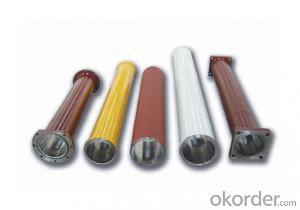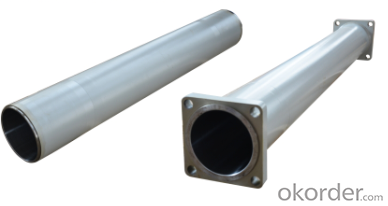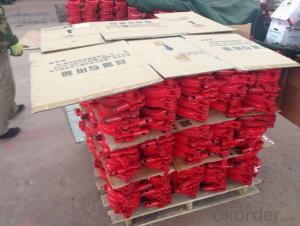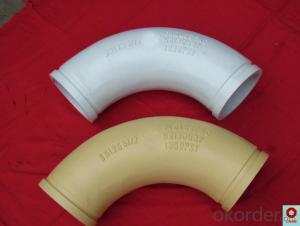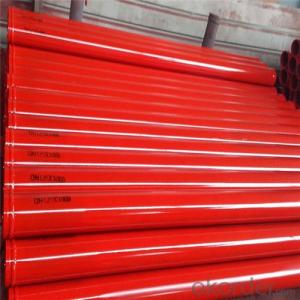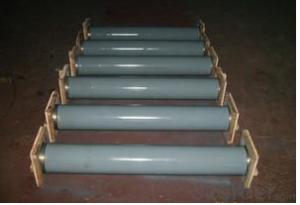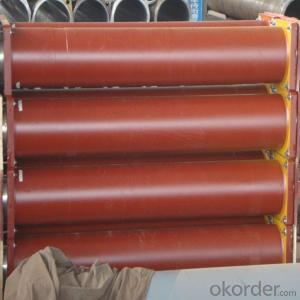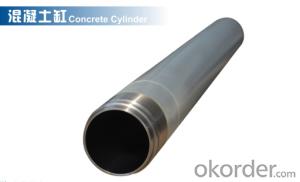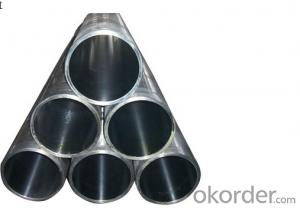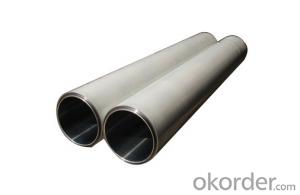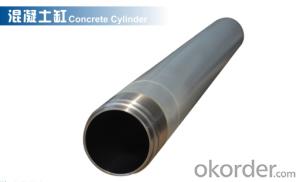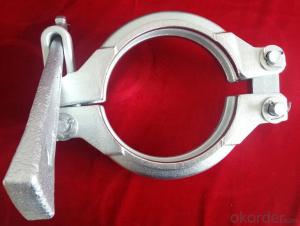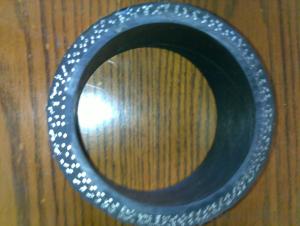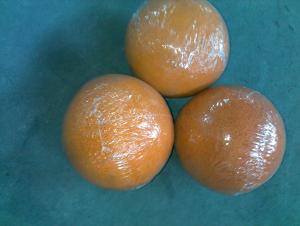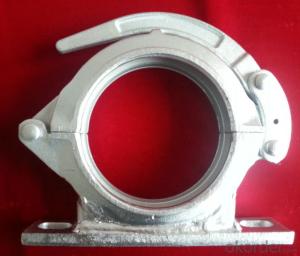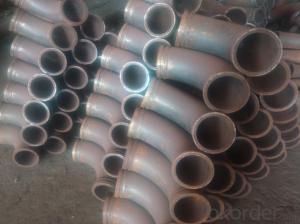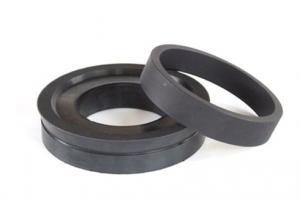PUMPING CYLINDER(SANY ) I.D.:DN180 CR. THICKNESS :0.25MM-0.3MM LENGTH:1530MM
- Loading Port:
- Shanghai
- Payment Terms:
- TT OR LC
- Min Order Qty:
- 2 pc
- Supply Capability:
- 1000 pc/month
OKorder Service Pledge
OKorder Financial Service
You Might Also Like
Product Description:
The Concrete Pump Delivery Cylinder normally made by steel material No. C45. according to customer’s requests, and also package in bundles or nude packing directly put into container.
Scope of Application of the Cylinders
The Pump Delivery Cylinder is a concrete pumping for combined use with other concrete pumps in concrete pumping operations. It can be widely used in the construction of various types of concrete structures like industrial and civil buildings, bridges, roads, and other types of infrastructure.
This Cylinder can only be used in concrete pump construction operations, but not in any other operations, like dragging, moving, or hoisting heavy articles or personnel. The pipe is also not allowed to be used in any location where any combustible or explosive material exists or a cave-in may occur.
Specifications:
Concrete Pump Delivery Cylinder DN180*1530
1. Capacity: 60,000~80,000cbm
2. Size: DN180, DN200, DN230..
4. Brand: SANY
5. Material: C45
6. Quenching and tempering to improve the hardness to HB241-280
7. Inner wall chrome thickness is 0.25-0.30mm, hardness HV820-900.
Product Advantages:
OKorder's Cylinders Channels are durable, strong, and safety.
Main Product Features:
· Premium quality
· Prompt delivery & seaworthy packing (10-20 days)
Reliable performance
Easy to weld
High safety.
· Professional Service
· Competitive pricing
Measuring of wall thickness from the outside
Low purchase cost
FAQ:
Q1: How long about delivery time?
A1: Normally we keep the raw materials for old customers and sometime we also keep stock products to make sure delivery time in any emergency cases.
Q2: How do we guarantee the quality of our Cylinders?
A2: We have established an advanced quality management system which conducts strict quality tests at every step, from raw materials to the final product. At the same time, we provide extensive follow-up service assurances as required.
Q3: How soon can we receive the product after purchase?
A3: Within three days of placing an order, we will book the vessel for goods. The specific shipping date is dependent upon international and government factors, but is typically10 to 30 workdays.
Q4: If we can produce some Cylinders according to customers request?
A4: Yes, we can produce Cylinders according to the difference country situations to make it suitable to the market and customers. We have very professional technical team to make the design.
Q5: How to make a quick resolution for after service?
A5: OKorder and our manufacture both have overseas branches all-around of world, If needed,
Concrete Cylinder | ||
Material | High Manganese Steel | |
Special | Coating hardness layer in the internalwall | |
Application | In concrete pump trucks | |
For Brand | Sany,Putzmeister,Schwing,,Zoomlion,CIFA etc | |
Details information | ||
Brand | Model | |
219 - DN180*1775-1600 | ||
Schwing | BP3000 | 219 - DN200*1775-1600 |
254 - DN230*2125-1800 | ||
DN230*2300mm | ||
DN230*2100mm | ||
Putzmeister | DN230*1600mm | |
DN200*1600mm | ||
DN180*2000mm | ||
40C1410 | 206-DN180*1530-1400 | |
50C1410 | 210- DN180*1545-1400 | |
60A1406 | 219- DN195*1570-1400 | |
Sany | 60C1416 | 226- DN195*1570-1400 |
60C1816 | 232- DN200*1946-1800 | |
C120/37A | 232- DN200*2162-2000 | |
C120/48 | 262- DN230*2146-2000 | |
62EA | 203-DN 180*1605-1400 | |
62G | 219-DN200*1187-1000 | |
62D | 219-DN200*1587-1400 | |
Zoomlion | 62H | 219-DN200*1787-1600 |
62CA | 219-DN200*1862-1600 | |
62M | 219-DN200*2022-1800 | |
0019931A | 219-DN200*2022-1800 | |
62L | 245-DN205*2284-2000 | |
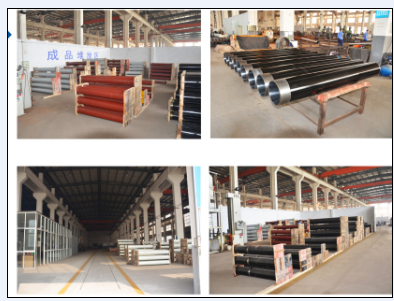

- Q: Are there any specific training or certifications required for handling and installing concrete pump spare parts?
- Yes, specific training and certifications are required for handling and installing concrete pump spare parts. Individuals working in this field usually undergo specialized training programs to gain a comprehensive understanding of the equipment, safety protocols, and proper installation techniques. Additionally, some manufacturers or organizations may offer certifications to ensure that professionals have met certain industry standards and possess the necessary skills to handle and install concrete pump spare parts effectively and safely.
- Q: Are there any specific guidelines for the disposal of old or damaged concrete pump spare parts?
- Yes, there are specific guidelines for the disposal of old or damaged concrete pump spare parts. It is important to properly dispose of these parts to ensure environmental sustainability and to adhere to local regulations. Here are some guidelines to follow: 1. Identify hazardous materials: Before disposing of any concrete pump spare parts, it is crucial to determine if they contain any hazardous materials such as oils, lubricants, or chemicals. These substances require special handling and cannot be disposed of in regular waste streams. 2. Separate recyclable materials: If the spare parts are made of materials that can be recycled, such as metal or plastic, it is recommended to separate them from other waste. Recycling these materials helps in conserving resources and reducing the strain on landfill sites. 3. Contact local waste management authorities: Different regions have different guidelines and regulations for the disposal of specific materials. It is advisable to get in touch with the local waste management authorities to understand the proper procedures for disposing of concrete pump spare parts in your area. 4. Arrange for proper disposal: Once you have identified any hazardous materials and separated recyclable parts, arrange for their proper disposal. This may involve contacting specialized waste management companies that can handle hazardous materials or taking them to designated recycling centers. 5. Avoid illegal dumping: It is essential to avoid illegal dumping of old or damaged concrete pump spare parts. This can harm the environment and may result in fines or penalties. Always dispose of these parts through legal and responsible channels. By following these guidelines, you can ensure the proper disposal of old or damaged concrete pump spare parts, minimize the impact on the environment, and comply with local regulations.
- Q: What are the signs of a malfunctioning hydraulic oil cooler?
- There are several signs that can indicate a malfunctioning hydraulic oil cooler. 1. Overheating: One of the most common signs is the engine or hydraulic system overheating. If the hydraulic oil cooler is not functioning properly, it may not be able to cool down the hydraulic fluid effectively, leading to increased temperatures in the system. This can result in reduced performance, increased wear and tear on components, and potential fluid breakdown. 2. Fluid Leaks: Another sign is the presence of hydraulic fluid leaks. A malfunctioning hydraulic oil cooler may have damaged or worn seals, gaskets, or hoses that can cause leaks. These leaks can be visible as fluid drips or puddles underneath the machinery or as oily residue on components. 3. Increased Noise: A malfunctioning hydraulic oil cooler may also cause increased noise levels in the hydraulic system. This can be due to air being introduced into the system, resulting in cavitation or aeration. These abnormal noises can indicate that the cooler is not functioning properly and may need to be inspected or replaced. 4. Elevated Temperatures: If you notice that the temperature gauge on your hydraulic system is consistently higher than normal, it could be a sign of a malfunctioning oil cooler. The cooler may not be able to effectively dissipate heat from the hydraulic fluid, causing temperatures to rise. This can lead to reduced efficiency, increased wear on components, and potential system failures. 5. Reduced Performance: A malfunctioning hydraulic oil cooler can also lead to reduced overall performance of the machinery or equipment. This can manifest as slower operation, decreased power output, or reduced hydraulic system response. If you notice a decrease in performance, it is worth checking the oil cooler for any issues. If you observe any of these signs, it is important to address the issue promptly. Continuing to operate machinery with a malfunctioning hydraulic oil cooler can lead to further damage, increased downtime, and potentially costly repairs. Consulting with a qualified technician or hydraulic specialist is recommended to diagnose and resolve any issues with the oil cooler.
- Q: How often should concrete pump accumulators be inspected and replaced?
- Concrete pump accumulators should be inspected at least once a year to ensure their proper functioning and identify any potential issues. However, the frequency of replacement depends on various factors such as usage, maintenance, and the manufacturer's recommendations. It is recommended to consult the equipment manual or contact the manufacturer for specific guidelines on replacement intervals.
- Q: How does a concrete pump S valve function?
- A concrete pump S valve functions by controlling the flow of concrete from the hopper to the delivery pipeline. It consists of two flat plates attached to a shaft that can rotate. When the S valve is in the closed position, the plates are pressed together to prevent the concrete from flowing through. As the shaft rotates, the plates separate, allowing the concrete to pass through and be pumped to the desired location. This mechanism ensures efficient and precise control of concrete flow during pumping operations.
- Q: What are the fittings of concrete pump?
- Fine stone concrete pump parts are: main oil cylinder, concrete cylinder, three-phase asynchronous motor, main oil pump, hopper, S pipe, electric distribution cabinet, hand oil pump, piston
- Q: How do I ensure the compatibility of mechanical components in concrete pump spare parts?
- To ensure the compatibility of mechanical components in concrete pump spare parts, it is crucial to consider several factors. First, it is important to identify the specific make and model of the concrete pump and its components. This information will help in sourcing the correct spare parts that are designed to fit and function properly with the existing system. Additionally, it is recommended to consult the manufacturer's documentation or reach out to their customer support for guidance. They can provide detailed specifications and compatibility guidelines for the mechanical components. It is essential to match the dimensions, tolerances, and materials of the spare parts to the original components to ensure a proper fit and optimal performance. Furthermore, working with reputable suppliers or distributors who specialize in concrete pump spare parts can greatly enhance compatibility assurance. These professionals have extensive knowledge and experience in the industry and can guide you in selecting the right components that are compatible with your specific concrete pump model. Regular maintenance and inspection of the mechanical components are also essential to identify any wear or damage. By addressing any issues promptly and replacing worn-out parts with compatible ones, you can ensure the overall compatibility and longevity of the mechanical components in your concrete pump spare parts.
- Q: How can a damaged concrete pump piston affect the pumping efficiency?
- A damaged concrete pump piston can significantly affect the pumping efficiency by compromising the seal between the piston and cylinder. This can lead to leakages and loss of pressure, resulting in reduced pumping force and efficiency. Additionally, a damaged piston can cause irregular movements and vibrations, leading to instability and potential damage to other components of the pump. Overall, a damaged concrete pump piston can hinder the smooth flow of concrete, decrease output, and require more energy to operate, ultimately affecting the pumping efficiency.
- Q: How often should hopper vibrators be inspected or replaced in a concrete pump?
- Hopper vibrators in a concrete pump should be regularly inspected to ensure their proper functioning and prevent any potential issues. The frequency of inspections or replacements may vary depending on several factors, including the intensity of use, operating conditions, and the manufacturer's recommendations. As a general guideline, it is advisable to inspect hopper vibrators at least once a year or every 500-600 hours of operation, whichever comes first. However, if the concrete pump is subjected to heavy use or operates in harsh environments, more frequent inspections may be necessary. During the inspection, the hopper vibrators should be checked for any signs of wear, damage, or loose connections. Additionally, the vibration intensity and frequency should be examined to ensure they are within the recommended range. Any issues identified during the inspection should be promptly addressed, either through repairs or replacements, to ensure the hopper vibrators continue to function optimally. Regular inspections and timely replacements of hopper vibrators are crucial to maintain the efficiency and reliability of a concrete pump. Neglecting these inspections can lead to decreased performance, increased downtime, and potentially costly repairs. Therefore, it is essential to follow the manufacturer's guidelines and consult with professionals to determine the appropriate frequency for inspections and replacements based on the specific circumstances of your concrete pump.
- Q: What are the common signs of wear and tear in a concrete pump cylinder?
- Some common signs of wear and tear in a concrete pump cylinder include: 1. Leaking oil or hydraulic fluid: If you notice oil or hydraulic fluid leaking from the cylinder, it is a clear sign of damage or wear. This can be caused by cracks, worn seals, or damaged gaskets. 2. Reduced pumping efficiency: A worn cylinder may result in decreased pumping efficiency, meaning the concrete pump may not be able to deliver the same amount of concrete as before. This can be due to a decrease in the cylinder's internal diameter or worn piston rings. 3. Increased noise and vibration: As the cylinder wears down, it may create more noise and vibration during operation. This can indicate misalignment, loose components, or damaged internal parts. 4. Rough or uneven concrete output: A worn cylinder can lead to a rough or uneven output of concrete. This can be caused by an irregular internal surface or damaged piston rings, affecting the smooth movement of the piston. 5. Excessive heat generation: If the concrete pump cylinder is worn, it may generate more heat during operation. This can be caused by increased friction between moving parts, which can further contribute to accelerated wear and tear. 6. Visible damage or corrosion: Inspecting the surface of the cylinder can reveal visible signs of wear and tear, such as scratches, dents, or corrosion. These damages can compromise the integrity of the cylinder and may require repair or replacement. It is important to regularly inspect the concrete pump cylinder and address any signs of wear and tear promptly to avoid further damage and ensure the pump's optimal performance.
Send your message to us
PUMPING CYLINDER(SANY ) I.D.:DN180 CR. THICKNESS :0.25MM-0.3MM LENGTH:1530MM
- Loading Port:
- Shanghai
- Payment Terms:
- TT OR LC
- Min Order Qty:
- 2 pc
- Supply Capability:
- 1000 pc/month
OKorder Service Pledge
OKorder Financial Service
Similar products
Hot products
Hot Searches
Related keywords
